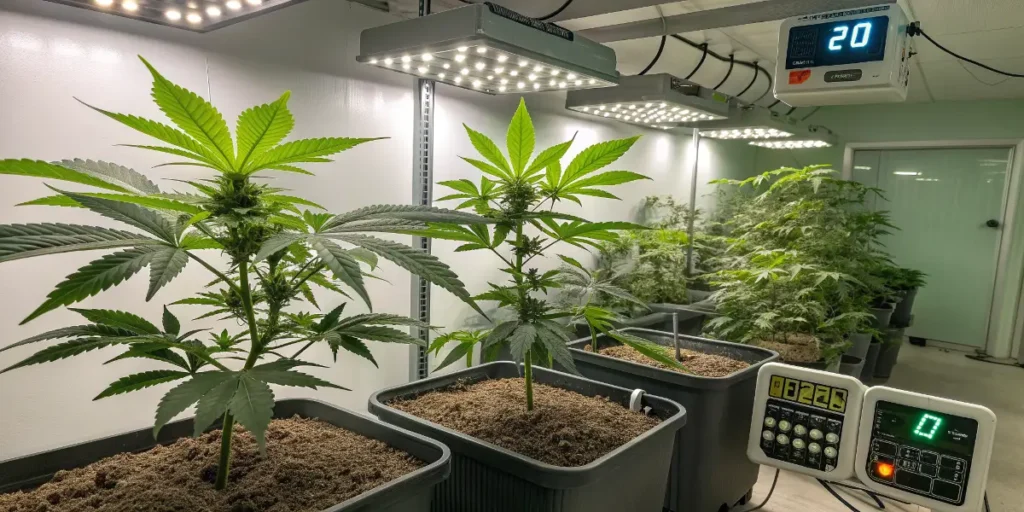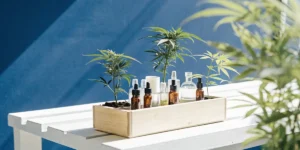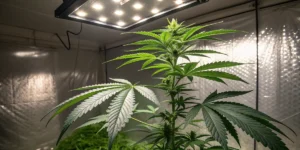Growing Sherbet Queen Auto can provide a rewarding experience, but it’s essential to understand its unique needs. This strain is prized for its high THC content and deliciously fruity flavors, making it a favorite among growers and users alike. The autoflowering nature of this strain means it has a shorter lifecycle, usually around 9-10 weeks from seed to harvest. This characteristic makes it an excellent choice for those looking to cultivate multiple cycles in a year or those who have limited growing windows.
The first step in growing this strain is selecting an appropriate growing medium. While soil is a traditional choice, many growers prefer using a soilless medium like coco coir due to its ability to retain moisture and promote healthy root development. If you choose soil, ensure it is rich in organic matter with good drainage capabilities. Additionally, using containers with adequate drainage holes can help prevent overwatering, which is critical for maintaining root health.
Lighting is another crucial factor when growing Sherbet Queen Auto. Since this strain is autoflowering, it doesn’t depend on specific light cycles to commence flowering. However, providing 18-24 hours of light daily can maximize growth and yield. LED grow lights are recommended for their energy efficiency and ability to deliver a full spectrum of light that closely mimics natural sunlight. Adjust the distance of the lights to ensure plants get enough light without the risk of burning the leaves.
Temperatures should be kept between 21-26°C (70-78°F) during the day and slightly cooler at night, while maintaining relative humidity levels around 40-50% during the vegetative stage, dropping to 30-40% during flowering. Consistent monitoring with a hygrometer and thermometer ensures a stable and optimal environment, which is critical for plant health and bud development. Sudden fluctuations can stress the plants, which could impact the final yield.
When it comes to nutrients, this strain benefits from a balanced feeding regimen. During the vegetative stage, a nitrogen-rich formula will encourage robust growth. As the plant transitions to flowering, switch to a formula higher in phosphorus and potassium to stimulate bud production. Be cautious of nutrient burn, a common issue when fertilizers are overused; start with lower doses and gradually increase as necessary.
Practice regular maintenance like pruning and inspecting for pests. Despite Sherbet Queen Auto’s resistance, vigilance is key. Pests such as spider mites or powdery mildew can still pose a threat. Pruning helps improve air circulation and light penetration, essential for healthy growth. Monitor the plant closely for signs of pests or deficiencies and address issues promptly to ensure a healthy and abundant harvest.
sherbet queen auto Strain Overview: Traits, Effects & Genetics
Sherbet Queen Auto is an autoflowering strain that has captured the attention of cannabis enthusiasts due to its rich array of traits derived from a notable lineage. Well-revered for its balanced profile, this strain stems from the model breeding of Pink Panties, which is a cross of Burmese Kush and Florida Kush. These genetics grant this strain a robust structure and resilience that are key identifiers for seasoned growers and beginners alike. Adding ruderalis genetics has further enhanced its attributes, ensuring rapid flowering times without the dependency on the photoperiod, which is ideal for growers seeking efficiency and stealth.
In terms of physical appearance, this strain is defined by its compact structure and attractive frosty buds, adorned with a spectrum of colors from deep purples to vibrant oranges. The trichome-rich flowers are not only a feast for the eyes but also a testament to its rich resin production, making it an excellent choice for those looking to experiment with concentrates. With an average height that generally ranges from 70 to 100 cm, it’s an unassuming plant that packs a punch, fitting perfectly into limited spaces without sacrificing yield.
The effects of this strains are noteworthy for their balance and potency, delivering a blend of relaxation and euphoria that is ideal for unwinding yet still engaging in creative activities. Users often describe a vivid sense of calm and uplifting energy, making it a popular choice for both recreational and medicinal purposes. The strain is known to alleviate stress and anxiety, while also offering relief from chronic pain and insomnia. Its terpene profile further enhances these effects, featuring a delightful mix of fruity and sweet aromas that make for a palatable and enjoyable smoking experience.
Genetically, this strain is a masterful mix that ensures both robust growth and superior effects. The blend of indica and sativa traits, heightened by the ruderalis influence, results in a strain that flourishes with minimal intervention. Whether you’re a novice grower or a seasoned veteran, Sherbet Queen Auto stands out as a user-friendly and rewarding strain that offers both impressive yields and high-quality buds. Its adaptability makes it a top choice for various grow environments, whether indoors or outdoors, underlining its universal appeal and versatility.
Optimal Environment to Grow Sherbet Queen Auto Successfully
When cultivating Sherbet Queen Auto, an autoflowering cannabis strain known for its robust flavor and vibrant effects, establishing the ideal environment is critical. Autoflowering strains, like this strains, are prized for their resilience and rapid growth cycle, making them a favorite among both novice and experienced growers. However, to maximize their yield and potency, certain environmental conditions must be met. Ensuring a stable and supportive environment is vital to achieving the best outcomes.
The lighting system is paramount for this strain, as it is for all cannabis strains. Although autoflowering varieties are less dependent on specific light schedules than photoperiod strains, they still thrive under sufficient lighting conditions. A full spectrum LED light is recommended, as it provides the broad range of light wavelengths that cannabis plants require. Aim for an 18/6 light cycle, which means 18 hours of light and 6 hours of darkness each day, to optimize growth and bud development during the short vegetative and flowering stages.
Temperature and humidity control are essential aspects of growing Sherbet Queen Auto. This strain flourishes in a temperature range of 20-28°C (68-82°F) during the day and slightly cooler at night. Proper control of humidity is also crucial; maintain relative humidity (RH) around 50-60% during the vegetative phase, and gradually reduce it to 40-50% during flowering to prevent mold and mildew, thus protecting the integrity and health of the plant.
Besides light, temperature, and humidity, proper soil quality and nutrient management should not be overlooked. A well-aerated, organic soil mix enriched with pertinent nutrients will nurture this strain well throughout its lifecycle. Autoflowering strains are generally less nutrient-hungry, but consistent feeding with balanced fertilizers that are rich in Nitrogen, Phosphorus, and Potassium during their growth phases will ensure robust growth. Always monitor pH levels to keep them within the 6-7 range for soil growth to enhance nutrient absorption and prevent potential deficits. By addressing these environmental factors, growers can successfully cultivate this strain and enjoy its rewarding yields.
Grow Room Setup for Sherbet Queen Auto Plants
When preparing your grow room for Sherbet Queen Auto plants, it’s vital to optimize the environment for this unique strain. Start by choosing a space large enough to accommodate these robust plants, which typically reach moderate heights. Ensure the room is clean, well-ventilated, and free from pests and contaminants that could affect the growth cycle. Consider using grow tents for better environmental control, as they allow precise regulation of light, temperature, and humidity.
Lighting is a crucial factor in the successful cultivation of this strain. Since autoflowering strains transition automatically from the vegetative phase to flowering, providing a consistent light schedule of 18-20 hours daily is optimal. LED grow lights are recommended due to their energy efficiency and ability to produce minimal heat, reducing the risk of heat stress on your plants. Position the lights at an appropriate distance to provide ample coverage without causing light burn.
Temperature and humidity are other critical elements in the grow room setup. this strain thrives in temperatures ranging from 20-26°C (68-79°F) with relative humidity levels between 40-50% during the vegetative stage and lowered to 30-40% during flowering to prevent mold and mildew development. Use a combination of thermostats, hygrometers, and oscillating fans to maintain these conditions, ensuring a consistent and advantageous environment for growth.
Proper air circulation within the grow room is essential for robust growth. Implementing an efficient ventilation system with intake and exhaust fans helps regulate temperature and humidity while ensuring a continuous supply of fresh air. Regular monitoring and adjustments are necessary to maintain optimum conditions, promoting the health and yield potential of your Sherbet Queen Auto plants.
Indoor Growing Tips for Sherbet Queen Auto
Growing Sherbet Queen Auto indoors can be a rewarding experience, offering cultivators a chance to savor the rich, creamy flavors combined with a powerful, relaxing high. To optimize your indoor space for this strain, start by selecting the appropriate growing medium and containers. Opt for high-quality soil or hydroponic systems depending on your experience and preference. Make sure your grow space has a ventilation system to maintain fresh airflow and prevent mold or mildew, which are risks in enclosed environments.
Lighting plays a crucial role in the growth of this strain. Since it’s an autoflowering strain, it doesn’t rely heavily on light cycles to start blooming. However, providing a stable and intense light source, such as LED grow lights, for about 18-20 hours a day can promote quick growth and maximize yields. Keep the lights adjusted at the optimal distance to avoid any light burn or inadequate lighting. Ensure that your plants receive enough light, but avoid excess heat, which can stress the plants.
Temperature and humidity control are vital in managing a successful indoor grow. This strainthrives in temperatures ranging from 21-26°C (70-79°F) and humidity levels between 40-50%. Use a combination of humidifiers, dehumidifiers, heaters, or air conditioners as needed to maintain these ideal conditions. Always monitor with a reliable thermometer and hygrometer. Avoid drastic fluctuations as this can impair plant growth and bud formation.
Nutrition is also key for robust plants and bountiful harvests. Auto strains like Sherbet Queen require a balanced feeding schedule. It is vital to focus on the correct NPK ratio (Nitrogen, Phosphorus, and Potassium) depending on the growth stage. Start with higher nitrogen levels during the vegetative phase and increase phosphorus and potassium as the plant approaches the flowering stage. Avoid overfeeding by watching for any signs of nutrient toxicity or deficiency.
Due to the fast and vigorous growth patterns of this strain, regular monitoring and maintenance are essential. Pruning and low-stress training can be beneficial in maximizing light exposure and ensuring uniform growth. Always use clean, sharp tools to avoid unnecessary plant stress. By following these indoor growing tips, you can ensure your Sherbet Queen Auto plants thrive and produce a high-quality harvest, providing an exceptional experience for growers and consumers alike.
Outdoor Growing Tips for sherbet queen auto
The Sherbet Queen Auto is a user-friendly strain for outdoor cultivation, favored for its resilience and ease of growth, especially for beginners. When growing this strain outdoors, it is vital to first consider the climate. This strain thrives in temperate, Mediterranean-like climates, characterized by warm temperatures and low humidity levels. It is crucial to sow the seeds after the last frost to capitalize on the longer daylight hours and avoid any low-temperature damage. Paying attention to the weather forecast and protecting the plants from unexpected cold spells can significantly enhance growth success.
Site selection is another important aspect when growing Sherbet Queen Auto outdoors. Choose a location that provides ample direct sunlight throughout the day, as this is essential for photosynthesis and optimal growth. Moreover, ensure that the site is well-drained to prevent waterlogging, which can lead to root rot and other detrimental issues. Raised beds or containers can be beneficial in areas with poor drainage. It is also advisable to choose a site with some protection from strong winds, which can damage delicate branches. A southern-facing slope can often provide the optimal sun exposure while offering natural windbreaks.
Nutrient management is key for maximizing the potential of this strain plants. It is advisable to start with a nutrient-rich organic soil medium to provide the necessary baseline for growth. Over time, plants will benefit from a balanced nutrient regime that includes nitrogen, phosphorus, and potassium, along with essential micronutrients. Regular feeding schedules tailored to the plant’s growth phase can ensure that nutrient needs are met. Be wary of over-fertilization, as it can lead to nutrient burn and might stunt the plant’s growth. Use soluble nutrients or teas to give the plants a gentle feeding if needed.
Watering practices should also be carefully managed to prevent stress on the Sherbet Queen Auto plants. While these plants are more drought-tolerant than some strains, consistent watering practices that maintain slight soil moisture can substantially boost growth and yield. During hotter months, increasing watering frequency may be necessary, but always ensure that the soil does not remain overly saturated. Consider using mulch to help retain soil moisture and regulate temperature fluctuations. This practice can also suppress weed growth, which often competes for resources.
Pest and disease management will keep your plants healthy and thriving. Regular inspections for common pests, such as aphids and spider mites, and the appropriate use of organic pesticide solutions can prevent infestations. Integrated pest management (IPM) strategies, including introducing natural predators, can also be effective. Ensuring adequate airflow around the plants and low humidity levels will minimize the risk of mold and fungal diseases. Early detection and treatment are vital, so keeping a keen eye on plant health is always recommended.
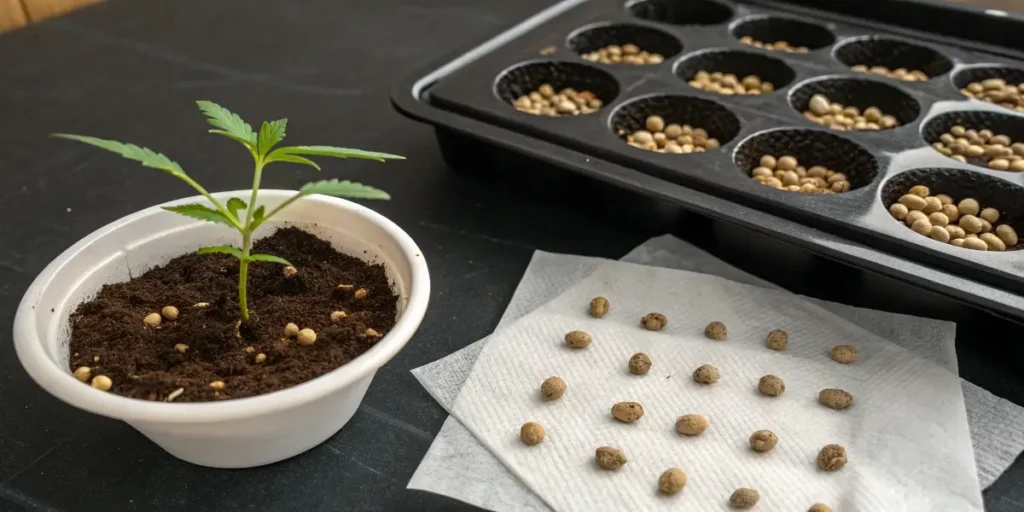
How to Germinate & Propagate Sherbet Queen Auto
When starting your Sherbet Queen Auto cannabis seeds, the germination process is a crucial first step. Since this strain is an autoflowering strain, the timeline is determined by the plant’s genetics rather than light cycles, which makes precision in germination even more important. Begin by gathering your materials: cannabis seeds, distilled water, a plate, and two clean paper towels. Moisten the paper towels thoroughly but ensure they are not dripping wet. Place one paper towel on the plate, then gently position the seeds atop it, spacing them evenly. Cover with the second damp paper towel and secure with an inverted dish to maintain humidity and darkness, ensuring optimal germination conditions.
Check the seeds daily to maintain the appropriate moisture level, as drying out can hinder germination. After 24-72 hours, the seeds should sprout a small taproot, indicating successful germination. When the taproot reaches approximately 1 to 2 centimeters in length, it’s time to transfer the seeds into their growing medium. Create a small hole about 1.5 centimeters deep in your choice of potting soil, gently place the seed taproot down into the hole, and cover lightly with soil. Ensure the soil is lightly moistened to encourage root growth and provide stability as the seedling emerges.
Propagation of this strain should proceed with care, as the plant’s autoflowering nature means you can’t afford to lose time during its lifecycle. Ensure your seedlings receive adequate light exposure, using either natural sunlight or high-quality grow lights, and maintain a warm temperature of 20-25°C (68-77°F) to foster healthy growth. Avoid excess watering, as autoflowering strains such as Sherbet Queen are particularly sensitive to overwatering; instead, allow the top layer of soil to dry out before re-watering. Following these guidelines will help ensure that your Sherbet Queen Auto seeds develop into strong, resilient plants, yielding a bountiful harvest.
Vegetative Stage
The vegetative stage is a crucial phase in the life cycle of your Sherbet Queen Auto plants, as it sets the foundation for a healthy and abundant yield. During this stage, the plants focus on developing strong stems and large foliage to support the later stages of growth. Ensuring optimal light, nutrients, and environmental conditions during this time will promote robust growth and prepare your plants for flowering. As an autoflowering strain, Sherbet Queen transitions quickly, so maximizing this period is key for achieving desirable outcomes.
This strain thrive in a well-balanced and controlled environment. Provide these plants with 18-24 hours of light per day, ensuring they receive ample energy for photosynthesis. LED grow lights are recommended for indoor cultivation, offering energy efficiency and appropriate light spectra for vegetation. Outdoors, position your plants where they receive adequate sunlight while being protected from harsh conditions. Mastering the light cycle will help your Sherbet Queen Auto to grow lush, with dense and leafy foliage.
Nutrient management is another vital aspect during the vegetative stage. This strain requires a balanced mix of nitrogen, phosphorus, and potassium along with trace minerals for optimal growth. Use a high-quality nutrient mix designed for the vegetative stage of cannabis, and adjust the ratios based on plant responses. Be cautious of over-fertilizing, as it can lead to nutrient burn or other growth impediments. Regular monitoring of pH levels, ideally between 6.0 and 6.5, will ensure nutrient uptake and prevent nutrient lockout.
Environmental conditions play a pivotal role in the development of Sherbet Queen Auto during the vegetative stage. Maintain temperatures between 21-26°C (70-78°F) and humidity levels around 40-70%. Adequate air circulation is necessary to prevent mold and pest issues, so ensure proper ventilation in indoor growing spaces. Periodically inspect your plants for any signs of stress or infestations, as early detection can save your crop from irreversible damage.
By focusing on these essential elements light, nutrients, and environmental conditions you can ensure that your plants are set up for success. A healthy vegetative stage will pave the way for a bountiful flowering phase, resulting in a gratifying and potent harvest. Meticulous attention to detail during this phase reaps long-lasting benefits, ensuring your efforts culminate in the finest quality buds.
Flowering Sherbet Queen Auto: What to Expect
Sherbet Queen Auto, a popular autoflowering cannabis strain, delights growers with its vibrant appearance and lightning-fast flowering time. In as little as 9-10 weeks from germination, this strain reaches the flowering stage, making it a top choice for those eager for a quick harvest. As flowering begins, you can expect the plant to produce dense, resinous buds that emit a delightful citrus aroma. This period is crucial for the plant as it shifts its focus from vegetative growth to bud production, showcasing its genetic potential inherited from parent strains.
During the flowering stage, this strain typically grows to a height of around 70-110 cm, making it suitable for both indoor and outdoor cultivation. For indoor growers, maintaining a consistent 18-20 hours of light per day can optimize bud development, whereas outdoor growers will benefit from planting during the sunniest months to maximize light exposure. Nutrient requirements shift during flowering; a higher ratio of phosphorus and potassium supports robust bud growth. Monitoring pH levels to remain within an optimal range is also key, ensuring nutrients are efficiently absorbed.
As it nears harvest, this strain exhibits striking hues of purple and orange on its buds, enhancing its visual appeal. Sticky with trichomes, it promises a potent yield that matches its vibrant appearance. Observing the trichomes to turn milky-white can help determine the precise harvest time for the desired effect, be it a heady high or a mellow body relaxation. Ultimately, cultivating Sherbet Queen Auto offers growers a straightforward yet rewarding experience due to its resilience, rapid growth, and delightful terpene profile.
To sum up, those cultivating this strain will find themselves rewarded with a fast-flowering crop that offers vigorous growth and a gratifying yield. Proper attention to its nutritional needs and environmental conditions during flowering can help maximize the quality and potency of its buds. Whether one is an experienced or a novice grower, Sherbet Queen Auto provides an accessible path to cannabis cultivation success, combining ease of growth with a delightful final product that is sure to please.
Fertilizers & Nutrient Schedule
When cultivating Sherbet Queen Auto, grasping the optimal feeding strategy is crucial for achieving robust growth and a bountiful harvest. This strain is renowned for its resilience and adaptability, thriving in a variety of growing conditions. However, to unlock its full potential, a well-structured nutrient regimen is essential. Begin with a balanced nutrient solution that caters specifically to the needs of autoflowering strains. This involves using a combination of macro and microelements that cater to the plant’s unique physiology, helping to establish a strong foundation during the vegetative phase.
The vegetative phase of this strain is relatively short due to its autoflowering nature. During this period, focus on providing a nitrogen-rich fertilizer to promote lush, green foliage. Products labeled as “veg nutrients” or “grow formulas” are ideal. Implement a light feeding schedule, starting with approximately half the recommended dose, and gradually increase based on plant response. Monitoring your plants closely for signs of nutrient burn or deficiency is crucial. Look for vibrant green leaves as an indicator that the nutrient balance is effectively supporting vegetative growth.
Transitioning into the flowering stage requires a shift in the nutrient mix. Decrease nitrogen levels and increase phosphorus and potassium to support bud development and enhance resin production. A high-quality bloom fertilizer will supply these essential nutrients, encouraging larger and more potent flowers. Continue with a sensitive approach by adjusting the nutrient concentration according to plant feedback, maintaining a feeding schedule of once every 1-2 weeks. Ensuring a steady but measured nutrient intake will prevent overfeeding, which could stress the plants and potentially damage yield quality.
Be mindful that this strain has a relatively short lifecycle, completing its development in approximately 8-9 weeks. As the plants near harvest, you may consider flushing them with plain water for 1-2 weeks to remove any residual salts and improve the flavor and smoothness of the final product. This practice is particularly beneficial in achieving a clean and enjoyable smoke. Lastly, always maintain pH levels between 6.0 and 6.5, as this range is crucial for nutrient uptake, maximizing your plant’s ability to absorb the fertilizers efficiently.
Pest and Disease Prevention for Healthy Cannabis Plants
A thriving garden of this strain requires proactive pest and disease prevention to ensure robust growth and bountiful yields. The first line of defense is maintaining a clean and orderly growing environment. Regularly sanitize tools, containers, and grow spaces to eliminate harmful pathogens. Ensure proper ventilation to reduce humidity levels, as damp conditions often serve as a breeding ground for detrimental fungi and bacteria. Consistent cleaning and organization significantly minimize the risk of infestations and outbreaks, providing a healthy start for your cannabis plants.
Moreover, integrated pest management (IPM) strategies play a crucial role in preserving the vitality of Sherbet Queen Auto plants. Begin by introducing natural predators like ladybugs or predatory mites, which effectively control common pests such as spider mites and aphids. Additionally, organic treatments like neem oil or insecticidal soap can serve as a secondary line of defense. When applying these solutions, adhere to manufacturer instructions to protect beneficial insects while efficiently targeting unwanted pests. A balanced IPM approach can maintain ecological harmony in your grow space, favoring plant health.
Another significant aspect of disease prevention is choosing disease-resistant strains, a quality inherent in this strain. Despite this inherent resilience, it remains important to employ preventive measures. Monitor plants for any signs of disease, such as discolored leaves or stunted growth, and act promptly to address any issues. Quarantine new plant arrivals and practice crop rotation to disrupt disease life cycles. The judicious observation and quick intervention help curb the spread of diseases, safeguarding your crop throughout its life cycle.
Fostering strong plant immunity through optimal nutrition is indispensable. Ensure your Sherbet Queen Auto plants receive a balanced supply of essential nutrients, encompassing macronutrients like nitrogen, phosphorus, and potassium, alongside trace micronutrients. This nutritional support not only boosts immunity but also enhances overall plant vitality. Employ regular soil tests to monitor nutrient levels and pH balance, adjusting feeding practices accordingly to meet the specific needs of your cannabis plants. Strong, well-nourished plants are naturally more resistant to diseases and pests, ensuring a healthy and productive garden.
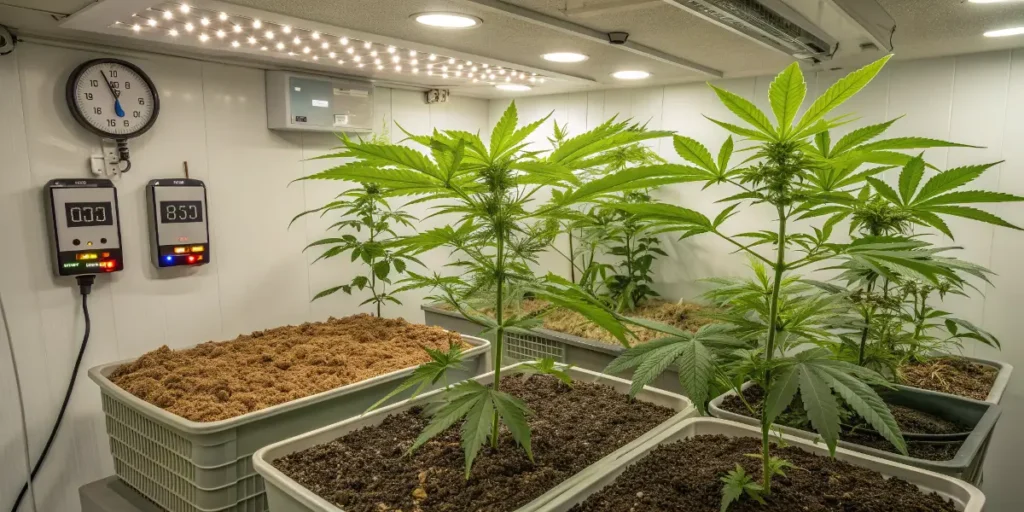
Harvesting & Drying the Right Way
Harvesting your Sherbet Queen Auto at the optimal time is crucial for maximizing its potency and flavor. Typically, the best time to harvest is when the majority of the trichomes, the tiny resin glands on the buds, have turned a milky white color, with some starting to show hints of amber. This stage indicates a peak in THC content, ensuring a more potent and enjoyable experience. As the plants reach maturity, closely monitor these indicators to perfect your timing.
When preparing to harvest, ensure you have the necessary tools ready, such as sharp scissors or pruning shears. Gently remove the fan leaves, as these do not contain significant levels of cannabinoids. Then, cut the branches at the main stem. It’s wise to prune during the early morning when terpene levels are at their highest, preserving the rich aromatic profiles that this strain is known for. Work in a well-ventilated space to avoid any unnecessary loss of these flavors.
Once the plants are harvested, the drying process begins, which is crucial in preserving the quality and flavor of your cannabis. Hang the branches upside down in a dark, cool room with a temperature around 18-22°C (64-72°F) and humidity levels between 45-55%. This environment helps prevent mold while allowing for a slow and steady drying process. Air circulation is paramount, so make sure the room is well-ventilated but avoid direct airflow on the buds, which can cause them to dry too quickly and lose their allure.
The drying process typically takes around 7-14 days. To test if your Sherbet Queen Auto is ready, bend a small branch; if it snaps delicately rather than bending, you can proceed to curing. This slow drying is crucial as it reduces chlorophyll, leading to a smoother smoke and enhanced flavor. Drying too quickly can make the cannabis harsh and less pleasant to consume, so patience is key for the best results.
sherbet queen auto Strain Type: Indica, Sativa or Hybrid?
Sherbet Queen Auto is a remarkable autoflowering cannabis strain that primarily leans towards the Indica side of the spectrum. This strain is renowned for its lineage, which traces back to Pink Panties and Sunset Sherbet, both of which carry strong Indica genetics. The influence of the Indica breeding is evident in the plant’s growth structure, effects, and appearance. Known for its compact stature and robust structure, this strain is an excellent choice for growers looking for a strain that is both manageable and rewarding, producing resin-coated flowers with a striking appearance.
While Sherbet Queen Auto is predominantly Indica, it is not entirely devoid of Sativa characteristics. This strain incorporates a hint of Sativa genetics, which brings about a balanced yet subtly energizing effect. Unlike pure Indica strains, which are typically heavily sedative, this strain delivers a more nuanced experience. The slight Sativa influence manifests in the cerebral high it offers, making the strain a versatile option for consumers seeking relaxation without complete couch-lock. The uplifting mental effects are complemented by the soothing body stone, offering a balanced high that caters to a wide range of preferences.
In terms of impact, the Indica dominance of Sherbet Queen Auto is discernible not just in its physical characteristics but also in its effects on consumers. Users can expect a sense of deep relaxation, ideal for unwinding after a long day or in meditative settings. The presence of Sativa genetics ensures that the strain doesn’t induce overwhelming lethargy, making it appropriate for daytime use by those who can tolerate stronger strains. This hybrid balance creates a strain well-suited for both recreational enjoyment and potential therapeutic applications, offering relief alongside a subtle yet discernible uplift.
Key Benefits for Cultivators
Sherbet Queen Auto has become increasingly popular among cultivators, both novice and experienced, due to its remarkable characteristics and rewarding benefits. Known for its resilience and ease of growth, this autoflowering variety is ideal for those looking to maximize yield without the associated challenges of traditional cannabis strains. As a compact strain with impressive productivity, this strain offers numerous advantages that make it a favorite choice among cannabis enthusiasts.
One of the primary benefits of growing Sherbet Queen Auto is its fast flowering time. Typically ready for harvest in just 8-9 weeks from germination, this rapid growth cycle allows for multiple harvests within a single growing season. This quick turnaround not only satisfies the impatience of cultivators eager to enjoy their harvest but also significantly boosts overall productivity, making efficient use of time and space.
Additionally, this strain showcases impressive resistance to common pests and diseases, reducing the need for intensive monitoring and maintenance. Its hardy nature makes it suitable for various growing environments, whether indoors or outdoors. As a result, growers can enjoy the peace of mind that comes with a robust, resilient plant that requires minimal intervention, which is particularly beneficial for those who may not have the time or experience to manage more demanding strains.
The Sherbet Queen Auto is renowned for its delightful sensory profile. It offers a pleasing blend of sweet and fruity flavors with subtle earthy undertones, providing a sensory-rich experience for consumers. Furthermore, its balanced THC levels, typically ranging from 15-20%, deliver a relaxing yet uplifting effect, appealing to both recreational and medicinal users. This combination of quality, efficiency, and resilience makes this strain an exceptional choice for any cultivator seeking a successful and satisfying growing journey.
Potential Challenges When Growing Sherbet Queen Auto
Growing Sherbet Queen Auto, a popular autoflowering strain known for its enticing aroma and robust effects, comes with its unique set of challenges. One major issue growers may face is managing the plant’s light cycle. Although autoflowering strains like this strain are less dependent on specific light schedules compared to photoperiod strains, ensuring consistent lighting is crucial for optimal growth. Beginners might underestimate this factor, leading to suboptimal yields. It’s crucial to maintain a reliable light source, such as LED or CFL, to avoid stunted growth.
Another potential challenge when cultivating this strain is ensuring it receives the right nutrients. Autoflowering strains can be more sensitive to nutrient levels than their photoperiod cousins. An imbalance, especially over-feeding, can lead to nutrient burn, manifesting in burnt leaf tips and compromised plant health. Fertilizers rich in nitrogen are beneficial during the vegetative phase but should be adjusted as the plant transitions to flowering. Observing the plants closely for any signs of deficiency or excess is essential for maintaining healthy growth.
Pest and disease management is another area where growers need to be vigilantly proactive. Although this strain is generally resilient, it’s not immune to common cannabis pests and diseases like spider mites, powdery mildew, and root rot. Regular monitoring and maintaining a clean grow environment can significantly reduce the risk of infestations or infections. Using natural pest deterrents, ensuring adequate air circulation, and maintaining appropriate humidity levels are critical steps to prevent such challenges.
Climate control poses a substantial challenge, especially for indoor growers. This strain thrives in stable environments; sudden changes in temperature or humidity can stress the plant. For outdoor growing, unpredictable weather patterns can pose increased risk. Implementing a reliable HVAC system indoors or choosing appropriate planting seasons outdoors your are critical considerations to mitigate these environmental impacts.
Here’s What You Need to Know
Sherbet Queen Auto is a noteworthy contender in the world of cannabis strains, particularly among those who prefer the convenience and speed of autoflowering varieties. This strain offers a blend of high potency, enticing flavor profile, and ease of cultivation, making it an attractive choice for both novice and experienced growers. With its heritage rooted in robust genetics, this strain can provide a rewarding cultivation experience. It features the advantageous characteristics of the original Sherbet strain, enhanced with autoflowering features for quicker harvests.
One of the main reasons growers might choose this strain is because of its rapid growth cycle. Autoflowering cannabis strains typically require less time from seed to harvest, and this cultivar is no exception, with a flowering cycle of just 8-9 weeks. This quick turnaround time allows multiple harvests in a single growing season if started early indoors or in greenhouses. This makes it a great option for growers looking to maximize their yield within a limited timeframe.
The flavor and aroma of this variety are other factors that can sway a purchasing decision. The strain is renowned for its sweet, citrusy notes, reminiscent of a refreshing sherbet dessert, complemented by earthy undertones. Upon inhalation, users are greeted with a balanced mix of sweet citrus and subtle berry notes, making it a sensory delight for those who prioritize taste. These flavors also translate into a smooth smoking experience, adding another layer of enjoyment for its users.
In terms of effects, these genetic is known for delivering a balanced blend of relaxation and euphoria. It contains a moderate to high THC content, typically ranging between 15-20%, which can provide an uplifting, creative head high, followed by a soothing body stone. This makes it suitable for both daytime and evening use, depending on the dosage. Medical users also appreciate this strain for its potential in alleviating stress, depression, and minor aches or pains.
Considering all these factors, Sherbet Queen Auto is definitely worth buying for those seeking a fast-growing, flavorful, and moderately potent cannabis strain. It caters to a variety of preferences, from those focused on taste and aroma to those looking for swift growth cycles. Whether you’re a home grower aiming for a personal stash or a commercial cultivator seeking reliable results, this strain offers attributes that can satisfy diverse needs, ensuring that it’s a solid investment for your cannabis cultivation venture.

FAQs about Sherbet Queen Auto
What is Sherbet Queen Auto?
Sherbet Queen Auto is an autoflowering cannabis strain renowned for its vibrant flavors and balanced effects. It is a cross between Pink Panties and Sunset Sherbet, offering a sweet, fruity aroma with a creamy texture. The plant is known for its fast growth cycle, making it ideal for both beginners and experienced cultivators seeking a hassle-free growing experience.
How long does it take for Sherbet Queen Auto to grow from seed to harvest?
Sherbet Queen Auto typically takes about 8 to 9 weeks from seed to harvest. This rapid growth cycle is one of the main attractions of autoflowering genetics. Its quick turnaround time allows multiple harvests per season, particularly beneficial for growers in regions with shorter growing seasons or those who aim for efficient indoor cultivation.
What are the typical effects of consuming Sherbet Queen Auto?
Consuming Sherbet Queen Auto usually results in a balanced high that combines both cerebral and physical effects. Users often report a sense of euphoria, relaxation, and enhanced creativity. This strain can also induce a calming body high that is not overstimulating, making it an excellent choice for evening use or when one seeks to unwind after a stressful day.
What are the ideal growing conditions for Sherbet Queen Auto?
Sherbet Queen Auto thrives in both indoor and outdoor environments but prefers a warm, sunny climate for optimal growth. It requires well-drained soil and a steady supply of nutrients to reach its full potential. Due to its compact size, it is well-suited for indoor growing setups where space is limited, making it a versatile strain for various cultivation settings.
What kind of yield can be expected from Sherbet Queen Auto?
The yield from Sherbet Queen Auto can vary based on growing conditions, but it generally produces medium to high yields. Indoor growers can expect approximately 325-425 grams per square meter, while outdoor yields can reach up to 150 grams per plant. Its robust nature and minimal maintenance requirements make it a rewarding choice for growers aiming for efficient harvests.

